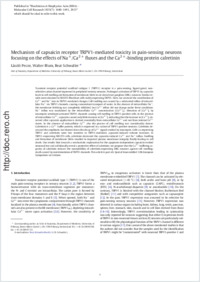Mechanism of capsaicin receptor TRPV1-mediated toxicity in pain-sensing neurons focusing on the effects of Na⁺/Ca2 + fluxes and the Ca2 +-binding protein calretinin
- Pecze, László Unit of Anatomy, Department of Medicine, University of Fribourg, Switzerland
- Blum, Walter Unit of Anatomy, Department of Medicine, University of Fribourg, Switzerland
- Schwaller, Beat Unit of Anatomy, Department of Medicine, University of Fribourg, Switzerland
-
05.09.2012
Published in:
- Biochimica et Biophysica Acta (BBA) - Molecular Cell Research. - 2013, vol. 1833, no. 7, p. 1680–1691
English
Transient receptor potential vanilloid subtype 1 (TRPV1) receptor is a pain-sensing, ligand-gated, non-selective cation channel expressed in peripheral sensory neurons. Prolonged activation of TRPV1 by capsaicin leads to cell swelling and formation of membrane blebs in rat dorsal root ganglion (DRG) neurons. Similar results were obtained in NIH3T3 fibroblast cells stably expressing TRPV1. Here, we assessed the contribution of Ca2 + and Na⁺ ions to TRPV1-mediated changes. Cell swelling was caused by a substantial influx of extracellular Na⁺ via TRPV1 channels, causing concomitant transport of water. In the absence of extracellular Na⁺, the membrane blebbing was completely inhibited, but Ca2 + influx did not change under these conditions. Na⁺ influx was modulated by the intracellular Ca2 + concentration ([Ca2 +]i). Elevation of [Ca2 +]i by ionomycin sensitized/activated TRPV1 channels causing cell swelling in TRPV1-positive cells. In the absence of extracellular Ca2 +, capsaicin caused only little increase in [Ca2 +]i indicating that the increase in [Ca2 +]i observed after capsaicin application is derived essentially from extracellular Ca2 + and not from internal Ca2 + stores. In the absence of extracellular Ca2 + also the process of cell swelling was considerably slower. Calretinin is a Ca2 + buffer protein, which is expressed in a subset of TRPV1-positive neurons. Calretinin decreased the amplitude, but slowed down the decay of Ca2 + signals evoked by ionomycin. Cells co-expressing TRPV1 and calretinin were less sensitive to TRPV1-mediated, capsaicin-induced volume increases. In TRPV1-expressing NIH3T3 cells, calretinin decreased the capsaicin-induced Ca2 + and Na⁺ influx. Swelling and formation of membrane blebs resulted in impaired plasma membrane integrity finally leading to cell death. Our results hint towards a mechanistic explanation for the apoptosis-independent capsaicin-evoked neuronal loss and additionally reveal a protective effect of calretinin; we propose that the Ca2 +-buffering capacity of calretinin reduces the susceptibility of calretinin-expressing DRG neurons against cell swelling/death caused by overstimulation of TRPV1 channels. This article is part of a Special Issue entitled:12th European Symposium on Calcium.
- Faculty
- Faculté des sciences et de médecine
- Department
- Département de Médecine
- Language
-
- English
- Classification
- Biological sciences
- License
-
License undefined
- Identifiers
-
- RERO DOC 118172
- DOI 10.1016/j.bbamcr.2012.08.018
- Persistent URL
- https://folia.unifr.ch/unifr/documents/303140
Statistics
Document views: 117
File downloads:
- pdf: 353
